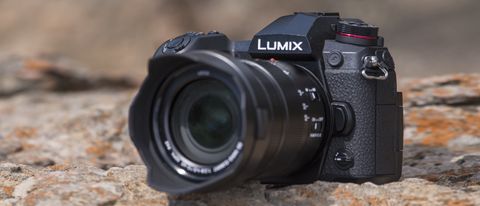Why you can trust TechRadar
Performance
- 20fps burst shooting with full AF
- 4K and 6K Photo modes
- 400-shot battery life
The Lumix G9 is capable of shooting at a blisteringly quick 20fps with full continuous AF, while this can be stretched a staggering 60fps if you don't need to track your subject. That's quite a jump from the GH5's 12fps (9fps with AF-C), while it's also possible to use the 4K and 6K Photo modes to extract still images. These modes might have less appeal with the G9 capable of shooting at such fast speeds, but it's possible to extract single 8MP and 18MP images from 4K 60fps and 6K 30fps footage respectively.
Just like the GH5 and a selection of other Panasonic mirrorless cameras, the Lumix G9 uses a 1,728-zone metering system to determine exposure. As we've experienced in the past, it's a very dependable system, and there were very few occasions when we needed to intervene and dial in exposure compensation.
We also found that the Lumix G9's auto white balance performed very well, with the camera delivering natural-looking results under a range of lighting conditions and light sources.
Using the 200mm f/2.8 (equivalent to 400mm don't forget) meant it was still possible to get pin-sharp shots even at modest shutter speeds
The Lumix G9's image stabilization system really impresses. The 6.5-stop compensation means it's possible to shoot at incredibly slow shutter speeds with wide lenses, while using the 200mm f/2.8 (equivalent to 400mm don't forget) meant it was still possible to get pin-sharp shots even at modest shutter speeds. This is certainly helped by the comparatively compact proportions of the lens making it a breeze to shoot handheld, while even with a 1.4x teleconverter attached it worked very well.
The electronic viewfinder is one of the largest to be built into a camera, and the display and shooting experience are excellent. It's large and bright and the use of OLED technology delivers good levels of contrast, while the refresh rate delivers a very smooth feed.
Battery life is rated at 400 shots – that's 10 shots less than the GH5, but it's fairly typical for a mirrorless camera of this class. You'll definitely want to invest in an additional battery or two to keep handy in your bag. One little annoyance is that the battery level isn't shown as a percentage - just four bars, so it's not always clear how much charge is left.
Image quality
- ISO100-25,600
- No optical low pass filter
- Good dynamic range
Image quality from the Lumix G9 is very good indeed, and it's certainly the best performance we've seen from a Micro Four Thirds-based camera.
Unencumbered by an optical low pass filter, the 20.3MP chip delivers really fine detail at lower sensitivities; you'd certainly struggle to tell the difference between results from the G9 and a comparable APS-C rival.
Panasonic has also worked hard to improve color rendition, and the G9 produces much more natural-looking and faithful colors in JPEG files than we've seen from other Lumix cameras in the past.
Results throughout the ISO range also look very good, with only a slight hint of luminance (grain-like) noise in the mid-range sensitivities when looking at raw files – you'll have to be looking really closely to notice it.

Click here to see the full-size image

Click here to see the full-size image

Click here to see the full-size image

Click here to see the full-size image

Click here to see the full-size image

Click here to see the full-size image

Click here to see the full-size image

Click here to see the full-size image
The G9 handles noise very well up to ISO3200 when shooting raw. At this sensitivity, as well as luminance noise being that bit more noticeable in shots, chroma (color) noise is also becoming more apparent. At ISO6400 the chroma noise is quite pronounced, but detail in raw files is very good considering. For JPEGs, the G9's noise reduction does a good job, controlling noise pretty well without sacrificing too much detail.
The G9 also delivers solid dynamic range performance. We found it possible to recover a decent amount of both highlight and shadow detail in JPEG files, while raw files offer even more latitude and flexibility.
Current page: Performance and image quality
Prev Page Build, handling and AF Next Page Verdict and competitionPhil Hall is an experienced writer and editor having worked on some of the largest photography magazines in the UK, and now edit the photography channel of TechRadar, the UK's biggest tech website and one of the largest in the world. He has also worked on numerous commercial projects, including working with manufacturers like Nikon and Fujifilm on bespoke printed and online camera guides, as well as writing technique blogs and copy for the John Lewis Technology guide.

Researchers produce thinnest sheet of metal ever using a 100-year old Japanese technique — Goldene could pave way for super catalysts, ultra high density optical storage and much more

Thomas & Uber Cup live stream 2024: how to watch badminton FREE online

A mystery Wear OS watch has just surfaced as the Pixel Watch 3 gets closer

